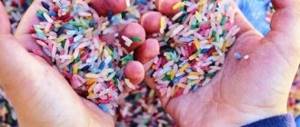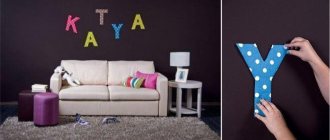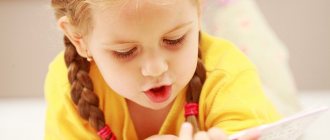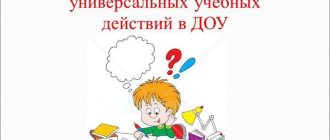Master class “Game choreography”
Master class “Game choreography”
Children's play is a means of actively enriching the personality, since it provides the child with activities that develop his unlimited capabilities and talents. The role of the game is truly enormous.
In addition to the main functions:
1. developing,
2. educational,
3. educational
Any game can implement a set of functions:
4. diagnostic
(revealing hidden talents),
5. relaxation
(reducing excess tension),
6. compensatory
(giving the child what he lacks),
7. communicative
(being a means of communication),
8. self-realization
(serving as a means of realizing opportunities),
9. sociocultural
(allowing one to master sociocultural norms and rules of behavior during the game).
The game is closely connected with all aspects of the educational process. Therefore, gaming technologies, like modern educational technologies, are actively used in choreography classes.
The purpose of gaming technology in the educational process is not to change the child and not to remake
him,
not to teach
him any special skills, but
to give the child the opportunity to “live”
situations that excite him
in the game with the full attention and empathy of an adult.
By implementing the main tasks, gaming technologies become one of the mechanisms for regulating the quality of training in choreography classes: they neutralize negative factors
, affecting the decrease in the effectiveness of training.
The integrated use of gaming technologies for different purposes helps prepare the child for further education:
1. forms motivational and emotional-volitional readiness
, since each game situation of a student’s communication with adults or with other children is for the child a “school of cooperation”, in which he learns to both rejoice in the success of his peer and calmly endure his failures, learns to regulate his behavior in accordance with social requirements, and learns equally successfully organize subgroup and group forms of cooperation;
2. forms intellectual readiness
through games aimed at developing mental processes.
At first, gaming technologies are used as individual game moments, which are very important, especially during the period of children’s adaptation to the team.
Starting from an early age, the main task of game moments is the formation of emotional contact, children’s trust in the teacher, the ability to see in the teacher a kind person, always ready to help (like a mother), an interesting partner in the game. The first play situations should be frontal, so that no child feels deprived of attention.
Further, gaming technologies, how gaming moments penetrate into all types of life activities of the pupil:
- educational activities and games;
- creative activity and play;
- everyday household activities related to the implementation of the daily routine and play.
A teacher using gaming technologies must have empathy, goodwill, be able to provide emotional support, create a joyful environment, and encourage any invention and fantasy of the child. Only in this case will the game be useful for the development of the child and the creation of a positive atmosphere.
When organizing a game, the teacher should rely on the already achieved level of development of children, their inclinations, habits, and abilities. Then carefully rebuild the existing interests of the students into the desired ones, gradually increasing the requirements for them, patiently and persistently working on their spiritual growth.
By enriching motor experience, active movement contributes to the pupil’s acquisition of skills and abilities in his independent activities: in play, in creativity, in all life activities.
With the help of outdoor games, students master new, more complex movements. Repeated repetition of these movements develops attention, will, coordination, and dexterity.
The teaching of young children must be based on play. It is necessary to make the game an organic component of the lesson. Playing in a dance lesson should not be a reward or relaxation after hard or boring work; rather, work arises from the play and becomes its meaning or continuation.
Properly selected and organized dance games during the learning process develop the ability to work and arouse interest in the lesson and work. Therefore, it is very important for us, teachers, to be attentive to the selection of repertoire for young pupils, to constantly update it, to make certain adjustments taking into account the time and characteristics of the children being taught.
Currently, there are many rhythmic and plastic movements, and one of the most accessible, effective and emotional is dance and rhythmic gymnastics. The availability of this type is based on simple general developmental exercises. Efficiency lies in its diverse effects on the musculoskeletal system, cardiovascular, respiratory and nervous systems of humans. Emotionality is achieved not only by musical accompaniment and dance elements included in dance-rhythmic gymnastics exercises, but also by figurative exercises and plot compositions that meet the age characteristics of students who are prone to imitation and copying the actions of humans and animals. The game method gives the educational process an attractive form, facilitates the process of memorizing and mastering exercises, increases the emotional background of classes, and promotes the development of thinking, imagination and creative abilities of the student.
Features of teaching methods. To perfectly master a huge variety of movements, combinations and entire sets of exercises included in dance and play gymnastics is possible only with the correct teaching methods.
The holistic process of learning gymnastic exercises and dancing can be divided into three stages:
- The initial stage is training in an exercise (a separate movement);
- Stage of in-depth learning of the exercise;
- The stage of consolidation and improvement of the exercise.
The initial stage of training is characterized by the creation of a preliminary idea of the exercise. At this stage of training, the teacher talks, explains and demonstrates the exercise. The demonstration of an exercise or individual movement should be bright, expressive and understandable, preferably in a mirror image. In dance and play gymnastics, demonstrating an exercise is the most essential link in the learning process, especially for pupils of younger groups, where the perception of movements is more associated with the visual analyzer. Correct demonstration creates an image-model of the future movement, forms an idea of it and the method of its implementation. If the exercise can be divided into component parts, it is advisable to use the dismembered method. For example: first study the movement only with the legs, then with the arms. Next, combine these movements together and only then continue further training in the exercise.
The stage of in-depth learning of an exercise is characterized by clarifying and improving the details of the technique of its implementation. The main task of the stage comes down to clarifying motor actions, understanding the patterns of movement, improving the rhythm, free and smooth execution of the exercise. The main method of training at this stage is the holistic execution of the exercise. The dissection of the movement occurs only if its details are clarified. The number of repetitions in one lesson increases compared to the previous stage.
The process of unlearning is significantly accelerated if it is possible to provide students with urgent information about its implementation. Such techniques in dance and play gymnastics include: performing exercises in front of a mirror, using sound cues (claps reflecting the rhythmic characteristics of the exercise, or specially selected music), musical time signatures, which contribute to better performance of exercises. Success at the stage of in-depth learning of the exercise also depends on the activity of the students. Increasing the activity of children is facilitated by changing the conditions for performing the exercise and setting certain motor tasks. In this case, students create motor representations of the movement being studied, first with music, and then without it. This facilitates rapid mastery of the exercise, clarification of its details, and motor actions. Only when the implementation of the exercise under study corresponds to its characteristic features, style of execution, and creates a certain school of movements, can we consider that this stage of forming the foundations of a motor skill is completed.
The stage of consolidation and improvement is characterized by the formation of a motor skill, with its transition to a skill of a higher order. The entire complex of the previous stage is used here, but the leading role is taken by the methods of learning as a whole - competitive and game.
The stage of improving exercises can be considered complete only when children begin to move freely with full emotional and aesthetic return. Only after this can this exercise be used with other previously studied exercises, in various combinations, complexes and dances.
In dance and play gymnastics, with its apparent simplicity of movements and vivid imagery of exercises to music, it is sometimes difficult to apply staged training.
The guiding and educational role of the teacher is to form a “school of movements”, a certain style of their implementation, and a conscious attitude towards learning.
The game process increases interest in activities of any complexity and stimulates active and creative work.
My students and I will show you four rhythmic gymnastics complexes:
The first complex of dance and play gymnastics is called “Cockerel”.
The purpose of this complex is to develop the sense of rhythm and motor abilities of pupils.
The goal of the complex is to teach how to freely, beautifully and coordinatedly perform movements to music, promote the development of a sense of rhythm, develop muscle strength, and form correct posture. The educational goal of the complex is to develop perseverance, hard work...
1. Learn the verse:
Cockerel - cockerel, golden comb,
Butter head, silk beard,
Why do you get up early and don’t let the kids sleep?
2. Clap the rhythm to the music with recitative.
3. Stomp the rhythm to the music with recitative.
4. We learn the movement of the arms with flapping and clapping on the hips (imitating the flapping of wings).
5. Learning leg movements. Triple stomp with a pause (during the pause, the extended toe of the working leg is raised to the knee of the supporting leg).
6. We combine the movements of the arms and legs in a complex.
The second complex of dance and play gymnastics is called “Laundress”.
This complex is used to develop a sense of rhythm and teach the elements of pop dance in the disco style.
1. “Washing clothes.”
Starting position: heels together, toes apart, arms bent at the ankles. Alternately squatting on each leg, straightening your arms, stretching forward, imitating washing.
2. “Rinsing laundry.”
Starting position: heels together, toes apart, arms bent at the elbows and laid to the side. Alternately squatting on each leg, swing your arms to the side.
3. “Wringing out the laundry.”
Starting position: heels together, toes apart, arms bent and in fists, extended forward. Springy side steps to the side, with our hands we imitate squeezing out the laundry.
4. "Shaking the laundry."
Starting position: heels together, toes apart, transfer the body weight to the right leg, the left leg is on the toe, extended to the side. We raise our free hands up and down, simulating shaking the laundry.
5. “Hanging up the laundry.”
The starting position is heels together, toes apart, arms extended in front of you, springy side steps to the side, hands clench and unclench.
The third complex “Mouse” is used to develop a sense of rhythm, acting skills, improve coordination and orientation in space, and become familiar with pop movements in the “rap” style.
1. “The mouse is sleeping.”
Starting position is the first free position, palms closed under the left cheek, simulating sleep, springing the legs under the ri.
Starting position is the first free position, arms at your sides, raise your right hand to the top, at the same time take a spring step to the side, stand in the starting position.
3. “We listen to the cat.”
Starting position is the first free position. We raise our right hand to the ear, transfer the body weight to the right leg, spring on the right leg, the left one on the outstretched toe, to the side. We shift our body weight to our right leg and “listen” with our left ear.
4. “Let’s go to the kitchen.”
With cheerful jumps we make a circle and return to the starting place (2 times).
5. “Open the refrigerator and eat sausage.”
Starting position is the first free position, spring with your legs, hands are alternately brought to your mouth and lowered down.
6. “Stroke your belly.”
Starting position is the first free position, transfer the weight to the right leg, imitate stroking the stomach with the left hand, transfer the body weight to the left leg, do the same with the right hand, then with both hands.
7. “Let’s run home.”
With cheerful jumps we make a circle and return to the starting place (2 times).
8. “Let’s go to bed.”
The fourth complex is “Dance of Five Movements”.
The goal of the “Dance of Five Movements” complex is to awaken in students the ability to improvise, self-expression, and provide an opportunity to put into practice the knowledge, skills and abilities already acquired. This complex can also be used to relieve physical and emotional stress, because... it is completely improvisational.
To perform the exercise, you need a recording with music of different tempos, lasting 1 minute for each tempo.
1. “Water flow.”
Smooth music, flowing, round, soft, moving one into another movement. Completed within one minute.
2. “Crossing the thicket.”
Impulsive music, sharp, strong, clear, chopping movements, drumming. Completed within one minute.
3. "Broken Doll."
Unstructured music, a chaotic set of sounds, shaking, unfinished movements (like a “broken doll”). Completed within one minute.
4. "Flight of the Butterflies."
Lyrical, smooth music, subtle, graceful, gentle movements. Completed within one minute.
5. "Peace."
Calm, quiet music or a set of sounds that imitate the sound of water, sea surf, sounds of the forest - standing without moving, “listening to your body.” Completed within one minute.
Note: after finishing the exercise, talk to the children about which movements they liked best, what was easy and what was difficult.
Self-analysis of the master class “Game Choreography”.
I chose the topic “Game Choreography” because dance-games arouse interest in classes and develop the ability to work. Dance-rhythm games in an accessible form have a diverse effect on the musculoskeletal system, cardiovascular and nervous systems of pupils.
- The master class is conducted with pupils of the junior group of the first year of study (5-6 years old).
The level of development of students’ dance skills corresponds to their age characteristics.
The theme of the master class is “Dance through play.”
Properly selected and organized dance games during the learning process develop the ability to work and arouse interest in classes.
The principle of building a lesson: from simple to complex.
Objectives set during the lesson, achieving the goal:
1. initial stage – teaching an exercise (a separate movement);
2. the second stage of in-depth learning of the exercise. Development of the musculoskeletal system.
3. stage of consolidation and improvement. Fostering a love for the art of dance.
Visual aids were used during the lesson. A verbal, practical method of teaching, which, in combination with the game method, gives the educational process an attractive and accessible form, facilitates the process of memorizing and mastering exercises, increases the emotional background of the lesson, and promotes the development of thinking, imagination and creative abilities of students.
A group form of classes was used.
The structure of the master class consisted of the following dance and game complexes:
1. Dance and game complex “Cockerel”.
The purpose of this complex is to develop a sense of rhythm and motor abilities of pupils
The objectives of the complex are: to teach how to perform movements correctly to music freely and in coordination, to promote the development of a sense of rhythm, and to develop muscle strength. Form correct posture. The educational goal of the complex is to cultivate a love for folk dance.
2. Dance and game complex “Mouse”.
Used to develop a sense of rhythm, develop acting skills, and become familiar with the movements of pop dance in the “rap” style.
3. Dance and game complex “Laundress”.
It is unlearned in order to develop dance and movement skills, to learn the elements of pop dance in the “disco” style.
4. Dance and game complex “Dance of Five Movements”.
The purpose of this complex is the development of thinking and imagination, the development of musical, rhythmic and coordination skills.
The objectives of this complex: the development of muscle strength, the ability to correctly recognize the nature of music and respond to changes in the tempo and nature of musical works.
Properly selected and organized dance games during the lesson arouse interest in the lessons, expand the range of motor activity of pupils, contribute to more diverse development, and develop the ability to work. Labor arises on the basis of play, becomes its meaning and continuation. I consider the main goal set during the lesson to be achieved. At the end of the master class, teachers evaluate what they saw, analyze the activities of the teacher, the skills of the children, their manner and technique of performance.
Conclusion. Summing up the results of the master class, we can say that achieving good results in teaching choreography is possible only if the teacher actively cooperates with students, parents, methodologists and fellow professionals. The latter is important because it gives teachers the opportunity to discuss their problems and receive timely, real help.
Position
Dance workshop
PE P EZLOADING
For mind and body for Choreographers and Teachers!
September 26 - 29, 2020 Anapa
You are a choreographer and you have a wonderful team!
Do you need a blast and recharge for your tired brain to generate new ideas for the new season?
Looking for a creative approach to creating productions?
Do you want to develop your ability to see ideas in everything?
Do you want a creative breakthrough and new solutions now?
Do you want to receive tools for successful production work?
Do you want to improve yourself in classes in modern and folk dance, stylization and neofolk?
Give the choreographer's mind and body Z
And we will help you with this!
Teachers who have created their own successful teams, who have a huge baggage of unique choreographic works, and who have their own methods and developments, will share their work experience with you.
For groups of 12 people or more SPECIAL OFFER!
As part of the dance workshop RELOADING, YOU CAN ORDER A STAGE OF A NUMBER
for your team.
Pay for participation in master classes, and receive a PRODUCTION OF A NUMBER AS A GIFT!
Each teacher-mentor can take only one production.
What awaits you at PERE Z LOADING:
- practice, practice and more practice
—
immersion in a laboratory for production work in three areas: modern dance, stylization and neofolk, folk dance.
— research and practical application of modern techniques
— technical classes in folk and modern dance
- stylization, neofolk - a modern view of Russian dance
— study of original choreography
- meeting with “brothers and sisters by blood” - CHOREOGRAPHERS from all over our vast country
— three days of immersion in the creative process
- a brainstorming session that will completely change your mind and revolutionize your work
WHAT YOU WILL GET AFTER REBOOT:
— Specific tools and methods of working on original productions
— Learn to generate ideas and see more around you, things that previously seemed ordinary and did not attract attention
— Ability to find creative compositional solutions
— A script for staging a new act created by myself.
— A new unique production that will belong only to you and your team
— You will learn to implement new ideas in productions
— Practical recommendations that will be shared by production teachers, whose works have been repeatedly awarded with special awards and prizes “For the best choreographers’ productions” at all-Russian and international competitions.
— New lexical material for working in a team
- Pleasure from the work done!
- Self-respect and faith in your strengths!
— Delight of children and parents!
- Audience recognition!
— Highly appreciated by the jury!
Perhaps you have not yet given the opportunity to birth your best choreographic performances that will lead your team to success!
In fact, there is enormous potential hidden in everyone.
- The main thing is not to be lazy!
- Repeat the material covered again
— Brainstorm
— Look at the idea from different angles
— Not to be alone, communicate with colleagues, exchange experiences, knowledge and ideas!
Forward! You will succeed!
Perhaps you have not yet given the opportunity to birth your best choreographic performances that will lead your team to success!
Come to hospitable Anapa at the height of the velvet season, extend your summer vacation, gain knowledge and take part in master classes by excellent teachers in the best “Art Hotel” on the Black Sea coast!
Applications are accepted until September 10!
You can submit an application by following the link https://forms.gle/s4Xmtrq5oxi4ygDT9
Or download from www.md-pride.com www.art-talant.com
send by email: [email protected]
Tel: +7-999-630-79-99
+7-918-28-555-90
8-800-100-48-80
come back
BALLET SCHOOL OF EGOR SIMACHEV
1. Ballet workshop
works with the best and most professional teachers and mentors, including current
ballerinas of the Bolshoi Theater
, artists of the Kremlin Ballet, the Stanislavsky and Nemirovich-Danchenko Theater, the ensemble named after. I. Moiseev and the Ministry of Defense of the Russian Federation.
2. Ballet and choreography lessons
are conducted according to specially developed
proprietary programs
that take into account the age and individual characteristics
of each child
.
From a very early age, children develop not only physically, but also spiritually and become culturally enlightened. This is also facilitated by our additional developmental classes in music, drawing, vocals, acting
, interesting excursions, creative master classes and lectures that we organize.
3. Our students quickly achieve their goals, become flexible, graceful, musical, expressive and liberated. They get sick less and develop harmoniously
, not only physically, but also spiritually.
At least twice a year they participate in large-scale costume performances
and bright
reporting concerts
, with the participation of soloists of the Bolshoi Theater and world ballet stars!
4. We created the world's first children's ballet troupe
with participants aged from 2 to 13 years old, which constantly performs and tours. Many festivals, competitions, and concerts give a child the opportunity to express his own creative self, demonstrate his talent, dance skills and extraordinary abilities in front of thousands of spectators!
5. We have an extensive network of branches, you can find the most convenient location for you. Individual training is also possible. Every year, students of Egor Simachev’s Ballet Workshop enter higher specialized institutions in Russia! Some of them are already performing on the stage of the Bolshoi Theater!!!
6. We have developed and successfully implemented special programs and methods of body ballet classes for mothers, allowing the mothers of our young ballerinas to also be in excellent physical shape.
And also for mothers with infants, allowing them to engage and develop together with their babies!
7. Our ballet school is the owner of three World Records!
And we do not stop there: we are constantly moving forward, coming up with something new that is interesting to us and our children, trying, experimenting, inventing. We cooperate with the most famous charitable foundations, provide support to young talents and children in need, and organize incredible events and events. We are a living organism, a creative laboratory, a ballet workshop! Welcome to our team, our family! Waiting for you! With love, Your Egor Simachev.
Methodology for conducting a master class on choreography
- safety regulations.
The theoretical part should not exceed 25-30 minutes, so the teacher needs to carefully consider and select the content and methods of presenting theoretical material.
To make the theoretical part of the lesson as meaningful and interesting as possible:
— use of visual and handout material;
Use of technical teaching aids;
— involvement of the children’s association students themselves in the preparation and presentation of theoretical material (starting from the second year of study);
— use of game teaching methods.
Practical part of the lesson
The teacher must divide practical work into certain stages, each of which will be performed sequentially and represents a certain completed part of the work.
The next step is the selection of specialized literature, handouts, selection and discussion of the most rational and technically correct working methods.
Then the teacher, together with the children, prepares the materials and tools necessary to perform specific practical work.
When performing group work, the teacher distributes parts of the work among students and determines how they will interact with each other.
Next, the children begin to perform practical work, and the teacher monitors their activities, provides assistance and advice, sums up the results and checks the correctness of each stage of the work.
When choosing the content of practical work, the teacher must consider:
- children's age;
— calendar period of the educational process;
-theme of the academic year;
-level of preparation of children;
— the latest current trends in this type of creative activity.
The following rules are very important when performing practical work:
— bringing each started work to completion;
— the obligation of its “external finishing” (i.e., bringing practical work to a level that allows it to be demonstrated);
— encouraging children’s desire to show the results of their creative activity.
End of class (last 15-20 minutes)
A few minutes before the end of the lesson, the teacher needs to warn the children about this. Completion of the lesson includes:
— summing up the results of practical work;
— consolidation of educational material;
- explanation of homework;
- organization of duty (if necessary).
Then the teacher says goodbye to the children and reminds them of the day and time of the next meeting.
Features of homework in the system of additional education for children:
— the optionality of its presence and implementation;
- creative character;
- for independent completion at home, only those stages (types) of work are given that do not require constant supervision from the teacher and mastery of complex technical techniques.







